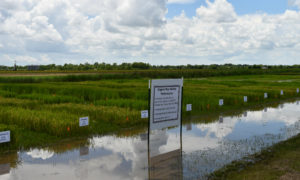Growing organic rice for market niche not simple
Writer: Kathleen Phillips, 979-845-2872, ka-phillips@tamu.edu
Contact: Dr. Shane Zhou, 409-752-2741, xzhou@aesrg.tamu.edu
Dr. Fugen Dou, 409-752-2741, f-dou@aesrg.tamu.edu
Dr. Mo Way, 409-658-2186, moway@aesrg.tamu.edu
Dr. Muthu, Bagavathiannan, 979-845-3041, muthu.bagavathiannan@tamu.edu
BEAUMONT — A market niche for organic rice has a potential to yield premium prices for farmers, but it’s more involved than simply planting the seed and forgetting it until harvest time.
That was the message from a team of researchers at the Texas A&M AgriLife Research and Extension Center-Beaumont during a recent field day at which experimental plots were showcased for area growers.
Rice scientists are conducting a three-year, multi-state, $1 million project exploring which rice varieties will yield best in an environment with no chemical treatments against diseases, weeds or insects. The idea is to be able to give farmers a “recipe” for growing rice organically, according to Dr. Shane Zhou, Texas A&M AgriLife Research plant pathologist in Beaumont and project leader.

“Currently, less than 2 percent of the total U.S. rice crop is organically produced,” Zhou said. “And most of that is grown in California and Texas.”
Six acres at the Beaumont facility are planted with rice varieties commonly grown in Texas. They’ve been subjected to a variety of treatments to determine how best to establish, grow and yield suitable harvests. Initially, the project started with 20 varieties in the tests. Half of those have since been cut from the project for not performing well enough.
This year, 10 varieties are showing varied quality of growth in experimental plots. Early indications show that cover crops of white clover, crimson clover and annual ryegrass performed best in Texas. Some of the varieties received a biocontrol seed treatment prior to planting to help control disease potential. The team is also exploring how much seed is needed for planting to establish an optimal stand.

“The higher the seed rate, the lower the weed count in the field,” said Dr. Fugen Dou, AgriLife Research integrated cropping systems nutrient management scientist, Beaumont. “Weeds are a major challenge because the grower can’t use any herbicides. There are also problems with seed rot and seedling diseases, and the grower can not use any seed treatment fungicides.”
For example, brown spot, a fungal disease, can occur on organic rice plants, due to a lack of nitrogen, which cannot be applied in its chemical form, Dou said.
“We have very limited options for providing enough nitrogen compared to conventional rice farming,” Dou said. “The soil typically does not have enough nitrogen to support the rice reaching its yield potential.”
That’s why nitrogen-containing cover crops, also referred to as “green manure,” like clover can be a boost, he said.
Winning the battle against weeds has focused on flooding the rice fields at certain times as the most important tool, according to Dr. Muthu Bagavathiannan, Texas A&M AgriLife Extension Service agronomist, College Station. He found that applying 3 inches of water to the test plots reduced germination of the most common species of weeds.
The worst insect pest for organic operations is the rice water weevil, according to Dr. Mo Way, AgriLife Extension entomologist, Beaumont.
“It lays its eggs underwater, then the eggs hatch and the larvae move down to the roots, where they feed,” Way explained. “The larval stage can do a lot of damage. When water is applied much earlier on organic rice to control weeds, that means the rice is much smaller and it only takes a few larvae to do a lot of damage.”
Way and his team have taken soil core samples from each of the variety plots, washed the roots over a fine mesh and counted the number of larvae present. This data will be analyzed to help determine control methods in organic production.
Bagavathiannan said finding the best practices for growing organic rice could pay off for farmers, because though the yields are usually much lower than conventionally grown rice, the price is often double.


